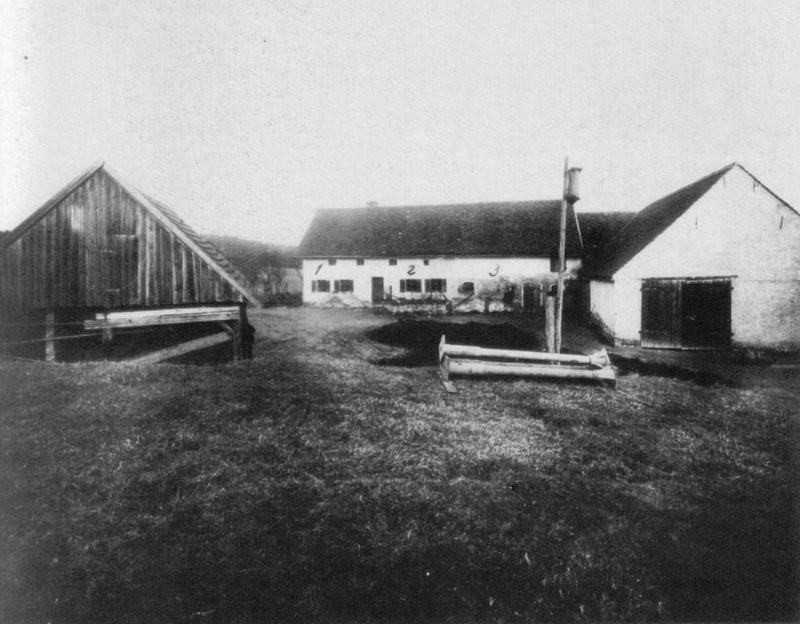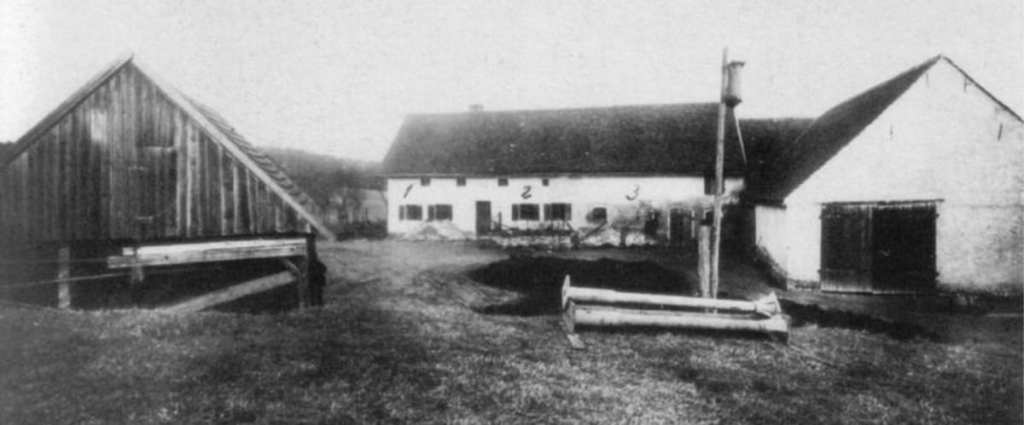If unresolved mysteries are your jam, you’re going to be totally up for digging into the details of this century-old case. There are not, however, many answers, though, so if that’s going to drive you nuts, well, it’s something to remember.
The Scene:
The Hinterkaifeck farmstead was located in a wooded area near Grobern, Germany, about an hour’s drive from Munich. Its occupants were 35-year-old Viktoria Gabriel, her 7-year-old daughter Cazilia, her 2-year-old son Josef, and her parents, Andreas and Cazilia Gruber.
Viktoria’s husband, the father of 7-year-old Cazilia (supposedly – we’ll circle back to this), had died a decade previously, in WWI.

Image Credit: Wikipedia
The family was known for keeping to themselves, so several days passed between neighbors noticing that Cazilia had missed school and when a few people decided to check up on them only to discover a grisly scene.
Four bodies were found in the barn, brutally battered to death with a blunt object or objects. Autopsy reports show that the parents were strangled and beaten, Viktoria died from nine “star-shaped” wounds to the face and head, and that the 7-year-old’s jaw was shattered and her face and neck had sustained gaping, circular wounds.
Experts believe the star-shaped marks were made by a mattock – a pickax-like tool – and that Viktoria and her parents likely died instantly from their wounds. Sadly, the little girl likely lay there for house in shock; she had ripped her own hair out in clumps.
In the house, new maid Maria Baumgartner – it was her first day on the job – was found killed by blows to the head and the 2-year-old dead from one, heavy blow to the face.
The Clues:
All of the bodies were covered, which suggests the person who committed the murders was close to them and felt emotional or uncomfortable at seeing them dead.
The dog and other animals were unharmed, but more than that, they had been fed and cared for in the days between the murder and the discovery of the bodies.

Image Credit: Wikipedia
The previous maid had quit after claiming the farmhouse was haunted; she reported hearing sounds in the attic and an unsettling feeling of being watched.
Though an investigation was held and a number of suspects were arrested, no one was ever charged with the murder. The case lingered on for decades, and even though it was finally closed in 1955, interrogations took place up until 1986. And now, the murders have gone so long unsolved that it is unlikely there will ever be a satisfactory conclusion.
Andreas Gruber dismissed the idea of a haunting but had reportedly told neighbors that strange things had been happening at the farm in the days before the murders – footsteps that led to the house from the forest but did not return, a newspaper he hadn’t bought found in the home, and a key to the house going missing.
The odd facts seem to add up to one thing: someone had snuck into the house and was living in the attic.
Someone who stuck around after murdering the family, keeping a fire going, caring for the animals, and eating the food from the cupboards.
The Suspects:
Police initially wanted to blame the horrific crimes on vagrants or traveling men of ill-repute, but after large sums of money were found in the house they were forced to abandon the theory. The fact that the bodies were covered, the murders were exceptionally brutal, and the person seemed to be familiar with the farm and its workings were also points that worked against the theories involving strangers.
The best suspect was a man named Lorenz Schlittenbauer, who was rumored to be the father of 2-year-old Josef. The two had planned to be married before Andreas interfered and ended the relationship (no word as to why) and Lorenz had married someone else. He and his wife had recently lost their first child in infancy, and police wondered whether the trauma, combined with his unwillingness to support Josef financially, had driven him to commit the brutal murders. He knew his way around the farm, led the initial investigative party when the bodies were discovered, and had been behaving oddly (handling the bodies without being weirded out, etc).

Image Credit: Wikipedia
In the end, they wrote his behavior off as shock, his knowledge of the farm as normal given his past relationship with Viktoria, and could never place him at the scene.
They briefly considered the fact that Viktoria’s husband, Karl Gabriel, might not have died in the war but several of his fellow soldiers attested to seeing his slain body in France. Plus, he would have no known motive.
Onto the creepiest of the suspects – Andreas Gruber. People had long discussed his penchant for incest and abuse, with most assuming Viktoria hadn’t been their only child, but simply the only one to survive into childhood. There was talk that the fatherless Josef could have been a product of incest, too, and police floated the theory that perhaps he had snapped, murdered the family, and then killed himself.
Ultimately, none of the injuries could be explained as self-inflicted so they dismissed that theory, as well.
Which left them with nothing and no one, and the case was closed. Though it was re-opened several times in the nex 95-years; the skulls were sent to Munich to be examined for clues but were lost during WWII. The farm was demolished in 1923 and the family (without their heads) are buried in a plot in Waidhofen, so little-to-no evidence remains from the crime scene, and even though the 2007 Furstenfeldbruck Police Academy worked the Hinterkaifeck murders as a cold case, all they came up with was a theory.
…that they refused to share out of respect for surviving family members of people related to the crime.
Which is to say, there’s very little chance these murders are ever getting solved.
But it sure is interesting.
Me? I don’t know who did it, but the biggest mystery of all is why on earth none of the family thought to, I don’t know, CHECK THE ATTIC after all of those odd happenings??
So weird.
You’re welcome.






